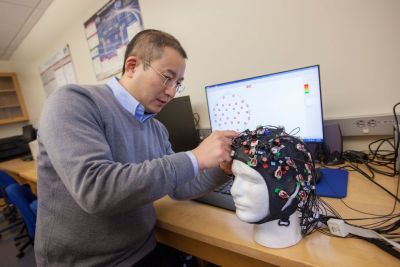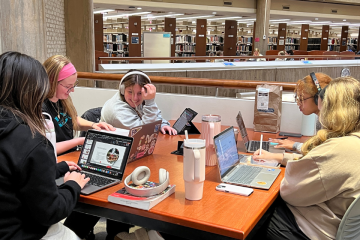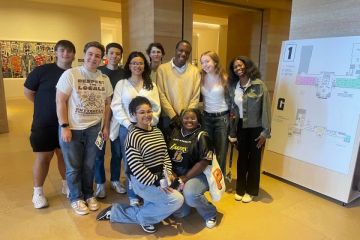Shedding Light on Gray Matter

The human brain is one of science’s great mysteries.
But a Widener student-faculty team is helping to shed light on the gray matter, conducting research that has the potential to change – and save – lives.
Imagine detecting Alzheimer’s or Parkinson’s disease years before symptoms appear, or helping someone with an amputated limb control his prosthesis with his mind.
“We’ve observed this in sci-fi movies like Star Wars. Now, it’s becoming real,” said Xiaomu Song, associate professor of electrical engineering, who is leading Widener biomedical and electrical engineering students in research in the growing interdisciplinary field of neuroscience.
Powering a Wheelchair
Student researchers huddle together in a hallway outside the university’s Medical Imaging and Brain-Computer Interface laboratory. One student, wearing a headset connected wirelessly to a laptop, sits in an electrical-powered wheelchair.
Without physically acting, the student imagines moving his left hand; the wheel chair veers left. He thinks about moving his right hand; the wheel chair goes right. He smiles; the wheelchair rolls forward.
This is the world of brain-computer interface – technology that creates a communication pathway between a wired brain and a device, such as a laptop, cell phone, or prosthesis. The field is on the cusp of improving the lives of people with damaged hearing, sight, and movement.
Software engineer Viraga Perera, who graduated in 2015 with a degree in electrical engineering and physics, worked on the initial team that used this technique. When Perera applied for a job at Harman Audio in Michigan, they were sold on his research experience.
The research gave me the skill set I needed. The insight I got and the hands-on experience put me in a position that I would not have had anywhere else. —Viraga Perera
Sports-related Concussions
The current research team is also jumping into the field of sports-related concussions and mild-traumatic brain injuries.
Too many blows to the head can cause short- and long-term effects that are debilitating and even deadly. But reliable diagnosis and evaluation, and protocols for treatment and monitoring, are difficult to develop without sufficient studies.
Enter Song and his students.
Thanks to a $91,500 research grant from the National Science Foundation, Widener purchased a neural recording system. The team is using the device to collect and analyze data as part of a multi-year, interdisciplinary project that could inform the tools used in the future for concussion diagnosis and treatment.
In partnership with the university’s athletic trainer and team physician, student-athletes who might have risked a sports-related concussion undergo testing with Song and the student researchers.
Early Diagnosis
Lastly, the research team is exploring ways to develop early indicators of neurodegenerative diseases, including but not limited to Parkinson’s, Alzheimer’s, and Huntington’s.
Using data gathered by doctors at Harvard and Duke universities, Song has developed multiple quantitative tools for functional magnetic resonance imaging (fMRI) to measure brain activity.
“We want to try to establish quantitative criteria to provide tools for early diagnosis,” he said. “For example, people with Alzheimer’s disease have apparent symptoms when they reach the middle or late phases of the disease, but in the early phase, there is almost no symptom. If we could find this in early phases, and start treatment, we could help people sooner.”
Luis Aguilar, who recently graduated with a master’s degree in biomedical engineering, calls the opportunities and equipment offered to student researchers at Widener amazing.
“There is a lot of good things going on here right now,” Aguilar said. “I wouldn’t have developed a passion for neuro-engineering had I not met Dr. Song and come to this lab.”



